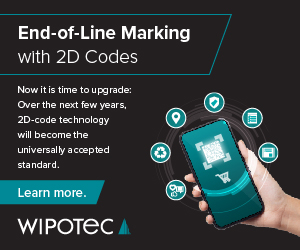Digital Transformation of Packaging
Today’s consumers are increasingly incorporating technology and digital tools into their everyday lives. They use smart devices to stay connected and informed, manage work and personal lives, and assist in household and shopping tasks. According to a recent GlobalData survey, consumers are very interested in digitally advanced solutions, with 64% saying they look for “high-tech” products when making purchase decisions. Packaging innovation is keeping up with this trend. Here are several ways digitalization is transforming the packaging industry.

Berlin Packaging | Premi Industries developed award-winning custom packaging for Ninu Perfume, the world’s first AI-enhanced sustainable smart perfume. The patent-pending system gives consumers the power to create their own fragrances on demand by mixing and matching scents via their smartphones.
SMARTPHONE CONNECTIVITY
Today’s consumers are always “on” and connected. People are spending more time online, and consumers are using their phones to purchase products and learn more about the brands they buy. According to GlobalData, more than half of global consumers (57%) are actively looking for smartphone connectivity when making purchases, and one in four Gen Z and Millennials say that interactive packaging is a key purchase driver. Smart packaging solutions – like quick response (QR) codes, radio- frequency identification (RFID) tags, and near-field communication (NFC) tags – can form a bridge between physical and digital realities. After scanning a code on the pack, shoppers are redirected to a brand’s website, where they can view product tutorials, browse other products, read reviews, discover ingredient information, find out about a company’s social or environmental initiatives, and more. With information at their fingertips, consumers can better scrutinize products and brands when making purchasing decisions. These smart packaging solutions provide reassurance, instill confidence, save time and money, and encourage trial.
AUGMENTED & VIRTUAL REALITY
A recent study by Beauty Packaging found that 92% of Gen Z consumers are interested in augmented reality (AR) during the shopping experience, and brands are using packaging to capitalize on this trend. Virtual and augmented reality applications can create multi-dimensional text, graphics, videos, and animation to bring a label to life and engage consumers in a unique and memorable way. 19 Crimes wines allow consumers to scan a QR code on the label to hear live stories of the infamous criminals featured on each bottle.
The gamification trend is also influencing package design. With gaming becoming more mainstream – 55% of digital consumers used their phones to play video games at least weekly in 2022 – the potential for AR packaging is huge. Coca-Cola Zero Sugar Byte is a limited-edition sparkling beverage launched in May 2022. By scanning a QR code on the can, consumers gained access to a unique metaverse environment within Fortnite that allowed them to explore what the pixels might taste like.
SAFETY
 Intelligent packaging can inform consumers about the state of a product or its environment through technologies directly in the package. Products and packaging are starting to incorporate embedded technology that informs consumers of its status. Companies use freshness sensors, temperature indicators, NFC technology, RFID tags, and other innovations to ensure freshness, track purchases, monitor inventory, and more. Coca-Cola introduced built-in temperature sensors that allow the company to see the temperature of the product during transportation and storage to ensure its quality and safety. Blue Lizard sunscreen uses Smart Bottles™ and Smart Caps™ that change color when exposed to UV light, reminding consumers to apply the product and stay safe from the sun.
Intelligent packaging can inform consumers about the state of a product or its environment through technologies directly in the package. Products and packaging are starting to incorporate embedded technology that informs consumers of its status. Companies use freshness sensors, temperature indicators, NFC technology, RFID tags, and other innovations to ensure freshness, track purchases, monitor inventory, and more. Coca-Cola introduced built-in temperature sensors that allow the company to see the temperature of the product during transportation and storage to ensure its quality and safety. Blue Lizard sunscreen uses Smart Bottles™ and Smart Caps™ that change color when exposed to UV light, reminding consumers to apply the product and stay safe from the sun.
AUTHENTICATION
The era of global trade and eCommerce has also increased the volume of fake goods in circulation, especially within the beauty care and luxury goods markets. New digital tools can help consumers authenticate luxury cosmetics, fragrances, and other high-priced products. Glass packaging producer Gerresheimer has partnered with TruTag Technologies to offer a secure digitization solution for cosmetic brands. According to TruTag, “the solution involves the integration of invisible microparticles that can be detected and decoded by a smartphone directly on the products.”
Contributor: Moira Stein, Insights & Strategy at Berlin Packaging
Bio: Moira has spent 20+ years working in brand marketing, with a focus on strategy and design. For the past three years, she has helped Berlin Packaging’s customers leverage consumer and category insights to develop strategic package design solutions that create impact and drive sales. Moira has experience across a variety of sectors, including food & beverage, personal care, and home care. Her clients have included large CPG companies like SC Johnson, Kraft, and ConAgra Foods, as well as small distilleries, wineries, craft breweries, and start-ups.







